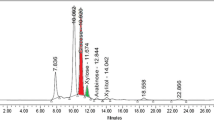Abstract
Diluted cane molasses having total sugar and reducing sugar content of 9.60 and 3.80% (w/v) respectively was subjected to ethanol production by Saccharomyces cerevisiae MTCC 178. Incorporation of dried Cauliflower Waste (CW) in molasses at the level of 15 % increased ethanol production by nearly 36 % compared to molasses alone. Addition of 0.2 % yeast extract improved ethanol production by nearly 49 % as compared to molasses alone. When the medium containing diluted molasses and 0.2 % yeast extract was supplemented with 15 % CW, 29 % more ethanol was produced compared to molasses with 0.2 % yeast extract. Cell biomass, ethanol production, final ethanol concentration and fermentation efficiency of 2.65 mg mL−1, 41.2 gL−1, 0.358 gg−1 and 70.11 % respectively were found to be best at 15% CW supplementation level besides reduction in fermentation time but further increase in CW level resulted in decline on account of all the above parameters. This is probably the first report to our knowledge, in which CW was used in enhancing ethanol production significantly using a small quantity of yeast extract.
Similar content being viewed by others
References
FAO (2006) Statistical data for agricultural crops. www.fao.org
Kulkarni M, Motey R & Lele SS (2001) Biotechnology in Agriculture, Industry and environment. Proc. of the International conference of SAARC countries organized by Microbiologists society at Karad, India pp. 24–31
Oberoi HS, Kalra KL, Gupta AK & Uppal DS (2007) Effect of addition of cauliflower waste on glucoamylase production by Aspergillus niger NCIM 1054. J Fd Sci Technol 44:509–512
Lin Y & Tanaka S (2006) Ethanol fermentation from biomass resources: Current state and prospects. Appl Microbiol Biotech 69:627–642
Kheshgi HS, Prince RC & Marland G (2000) The potential of biomass fuels in the context of global climate change; Focus on transportation of fuels. Ann Rev Energy Environ 5:199–244
Dubois M, Giles KA, Hamilton JK, Robert PA & Smith F (1956) Colorimetric method for determination of sugars and related substances. Anal Chem 25:350–356
Miller G (1959) Dinitro salicylic acid reagent for determination of reducing sugars. Anal Chem 31:426–428
Standing CN, Fredrickson AG & Tochina HN (1972) Batch and continuous culture for two substrate systems. Appl Microbiol 23:354–364
Rao JS, Singhal, RS & Kulkarni PRJ (1998) Xylose syrup from cottonseed hulls: optimization of hydrolysis conditions and purification by ion exchange resins. J Sci Ind Res 57:196–200
Devi SP & Singh HD (1995) Bioconversion of water hyacinth hemicellulose and xylose rich sugar mixtures to ethanol by Neurospora crassa. Enz Microb Technol 8:149–152
Gil-Hwan An, Byung-Gui Jang & Myung-Haing Cho (2001) Cultivation of the carotenoid-hyperproducing mutant 2A2N of the red yeast Xanthophyllomyces dendrorhous (Phaffia rhodozyma) with molasses. J Biosci Bioengg 92:121–125
Zanichelli D, Carloni F, Hasanaj E, Andrea ND, Filippini A & Setti C (2007) Production of ethanol by an integrated valorization of olive oil by products. The role of phenolics in inhibition. Env Sci Poll Res 14:5–6
Rozes, N, Arola, NL & Bordans A (2003) Effect of phenolic compounds on the co-metabolism of citric acid and sugars by Oenococcus oeni from wine. Lett Appl Microbiol. 36:337–341
Stehlik-Tomas V, Zetic VG, Stanzer D, Grba S & Vahcic N (2004) Copper and managnese enrichment in yeast Saccharomyces cerevisiae. Food Technol Biotechnol 42:115–120
Grohmann K, Cameron RG & Buslig BS (1996) Fermentation of orange peel hydrolysates by ethanologenic Escherichia coli. Effects of nutritional supplements. Appl Biochem Biotechnol 57–58:383–388
Reddy LV & Reddy OVS (2006) Ethanol production from dried mango peel and effect of nutrient supplementation. Poster no. [P9.08]. Sustainability of the Agri Food Chain, The Hague, Netherlands, Nov 7–9
Ensminger AH & Esminger MKJ (1986) Food for Health: A Nutrition Encyclopedia. Clovis, California: Pegus Press; PMID: 15210
Nancib A, Nancib N, Meziane-Cherif D, Boubendir A., Fick M & Boudran J (2005) Joint effect of nitrogen sources and B vitamin supplementation of date juice on lactic acid production by Lactobacillus casei subsp. rhamnosus. Bioresour Technol 96:63–67
Patil SG & Patil BG (1989) Chitin supplement speeds up the ethanol production in cane molasses fermentation. Enz Microb Technol 11:1138–1143
Author information
Authors and Affiliations
Corresponding author
Rights and permissions
About this article
Cite this article
Dhillon, G.S., Bansal, S. & Oberoi, H.S. Cauliflower waste incorporation into cane molasses improves ethanol production using Saccharomyces cerevisiae MTCC 178. Indian J Microbiol 47, 353–357 (2007). https://doi.org/10.1007/s12088-007-0063-1
Received:
Revised:
Accepted:
Published:
Issue Date:
DOI: https://doi.org/10.1007/s12088-007-0063-1




